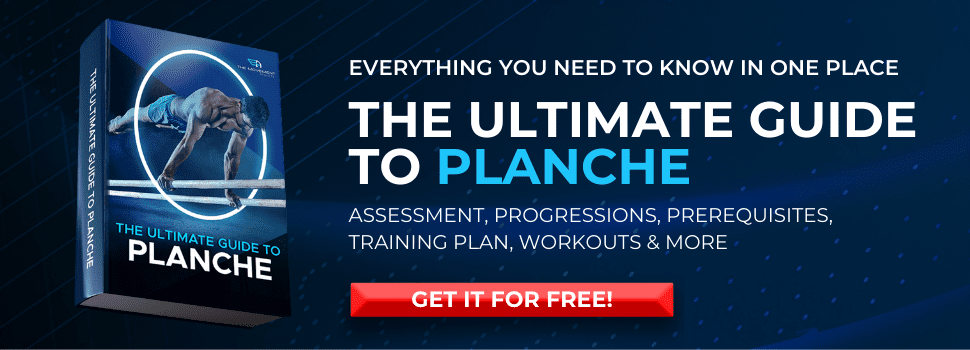TABLE OF CONTENT: The Ultimate Guide to Planche
1. 🧐What is a Planche ? 2. ✅Planche Benefits 3. 🤸♀️Planche – Muscle used and Requirements 4. 📌Planche Training Injury Prevention 5. 🔑How to perform a perfect planche 6. ☑The most effective planche progression 7. ⭐Expert’s effective tips for the perfect planche 8. 🍄Boost planche progress – the most effective planche drills 9. 🔥Planche workout – for all levels 10. 💪Planche training equipment 11. 🤩What’s next after planche? – advanced planche transitions and variations.
THE BEST PLANCHE PROGRESSION
If you have been aiming to learn the coveted calisthenics planche, then we have the most effective and realistic method for you.
But first, let’s talk about what it’s going to take to learn the skill.
Planche isn’t a skill that you can learn from training random exercises or by just getting strong. Although it’s considered a strength-based skill, general pushing strength will not get you planche.🥺
Planche requires high specific strength and mobility which you can read more of this here: 📍“Planche Muscles Used & Requirements.
Being a strength-based skill, obviously strength is a vital component. Combined with proper mobility, skill, muscle and endurance, and applying them in a well-structured program appropriate for your level, then you’ll have a productive time every session towards planche.
Within this program should have a set of progressions that builds everything you need for the full planche. Progressions are everything in calisthenics.🔥
This is exactly what The Movement Athlete can provide you for your dream, planche: progressions.
So what are progressions? 🤔🤔🤔
Progressions are a set of exercises that covers the mentioned fitness attributes so you can work your way to a particular skill. It starts from the basics and levels up until you reach your goals. It’s basically the way to add intensity so you can develop the necessary requirements for a move.
✨Luckily, even an advanced skill such as a planche has progressions that you can start with earlier in your journey.
After each progression, the next one will be harder and harder. 💪 It will integrate more complex elements as well as increase the intensity of the exercise. You’re kinda like playing a video game. Each progress you make, the level gets harder.
This goes on until you reach the coveted full planche.
⚡️WHERE TO START
As mentioned earlier, you can start pretty early for your planche journey despite the high requirements for holding the full planche. You can start making progress early in your journey.
These are minimum requirements to start with specific training:
- 🏆 Bodyline fundamental
- 🏆 Push-up fundamental
Bodyline fundamentals ensure your core stability and that you have proper posture to hold the earliest stages of planche training. Having a strong core in not enough but it could help. What matters more is specific core strength by having good bodyline fundamentals.
Planche is a pushing exercise and if you have read our intro about planche:📍What is a planche, then you’ll know that it “simulates” the push-up position. That’s why general pushing strength gives you a massive advantage when learning the skill. Of course, more specific pushing strength is required to hold a planche.
If you have mastered these two, you can start your planche journey ASAP.💯 If not, work on these fundamentals as heading straight to planche training will lead to very slow progress or even worse; injury.
You can start with our Movement Athlete Assessment to get a better gauge on where to start your planche training.
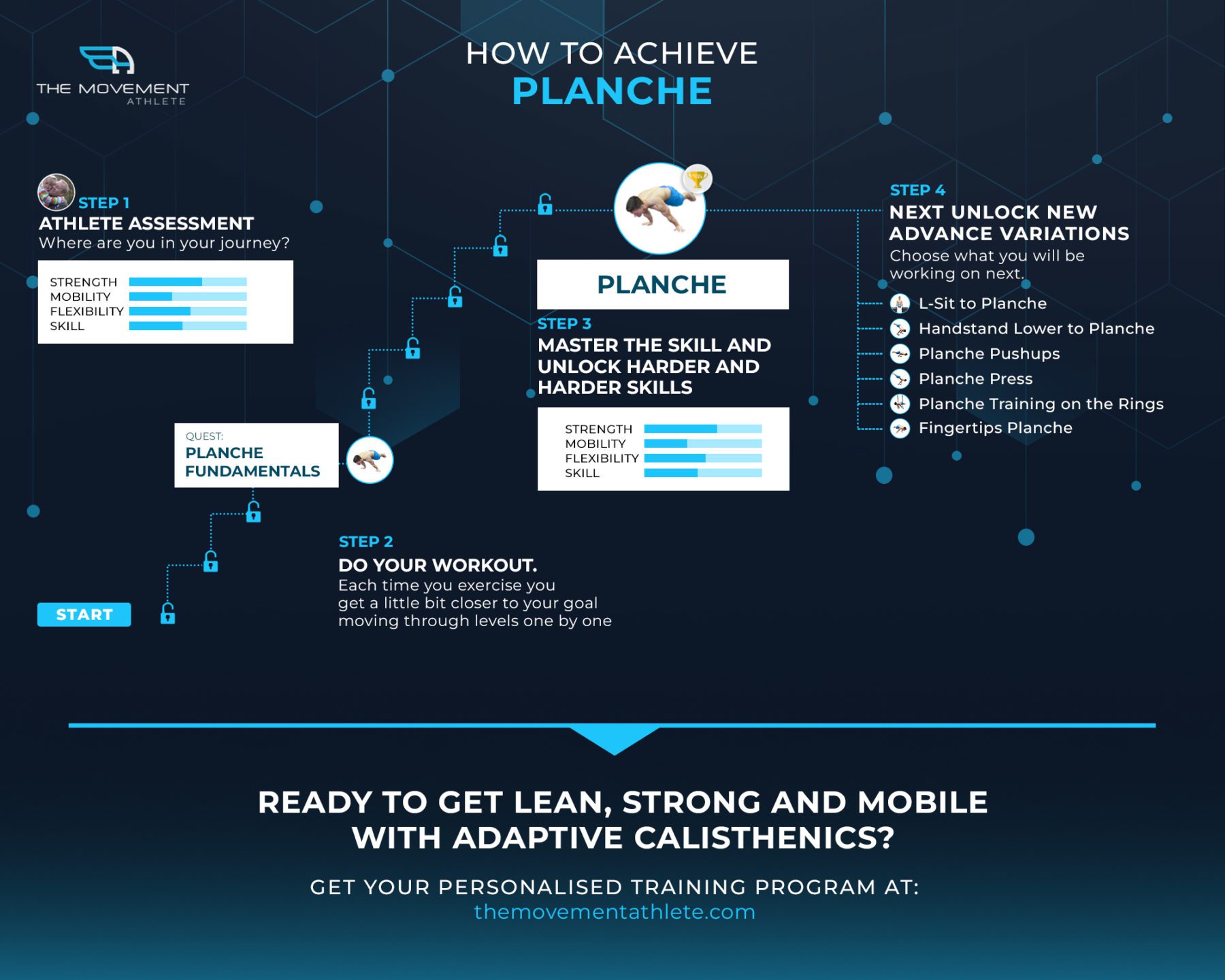
When Should I Progress?
Sometimes, it’s easy to overestimate your skills especially when you feel strong and confident. We recommend that you take things slowly when progressing. Be sure to be comfortable with the current step before moving forward.
Training progress is highly individualized. Only you can surely know when you’re ready to progress. Don’t worry. With The Movement Athlete, we can guide you as long as you train honestly.
PLANCHE TRAINING STRUCTURE
The training structure consists of progressions that covers all the elements that you need to master in order to master the skill.
When building a training program for any calisthenics skills we always use 4 categories to achieve overall development geared towards your goals:
- ✅ Strength
- ✅ Skill
- ✅ Muscle
- ✅ Endurance
Let’s look at each one of those separately in relation to planche work.
👊SKILL WORK
Planche is a very technical skill and is not just about brute strength. There are specific cues and techniques required mastery of in order to perform it efficiently with perfect form. This will be tackled alongside mobility exercises which benefits strength and skill work all together.
🎯STRENGTH WORK
General strength works a massive advantage for your planche training but specific planche strengthening exercises are our primary focus. These are high intensity exercises which every level has a suitable equivalent variation. Planche strengthening exercises should always be challenging to recruit the muscle fibers and build the skill for planche as well. Both straight-arm and bent arms exercises are included for the most efficient progress possible.
💪MUSCLE WORK
Bigger muscles exhibit more potential to get stronger. In the planche training, muscle work focuses on developing upper-body musculature specific for planche as well as eliminating any possible weaknesses in your body.
🏃ENDURANCE WORK
Planche involves a lot of body holds with proper bodyline. Whether it be static or dynamic exercises, all include a rigorous training of the core. Upper-body also works for longer periods of time to generate volume to ensure strength and muscle gains. Endurance work focuses primarily on core endurance, shoulder stabilization and straight-arm work.
Most training programs divide these elements into separate days.
In The Movement Athlete program, we bring them all together in a single day for the most efficient training that’s suitable for the real world.
Why do we do it this way?
In a world where we have all the time of the world, always full of energy, equipment and resources, we would want to train these elements separately. It’s also beneficial to have separate goals on each day to maximize the output of each training.
Oftentimes, professional athletes train like this. Each day has a dedicated goal which prevents interference of any fatigue. They get to focus on a particular aspect. They also train multiple sessions a day, six days a week and get paid to do that.
Unfortunately for us folks, we do not have the luxury of time, resources and energy to commit to such a schedule.
This is why The Movement Athlete puts its focus on different aspects. It allows a more realistic way to train on a tight schedule. This doesn’t hinder our progress but even promote it as we are unable to train for hours within a day while still covering the important elements of our goals.
PLANCHE PROGRESSION
STAGE 1: TUCK PLANCHE
Achieving a planche its a long journey that’s why in The Movement Athlete we divided the training into two stages;
STAGE 1. TUCK PLANCHE
STAGE 2: FULL PLANCHE
In this article we will focus on the progression to full planche but if you want to access all the exercises please download our PDF of The Ultimate Guide to Planche or signup for our free version of the app through the free assessment
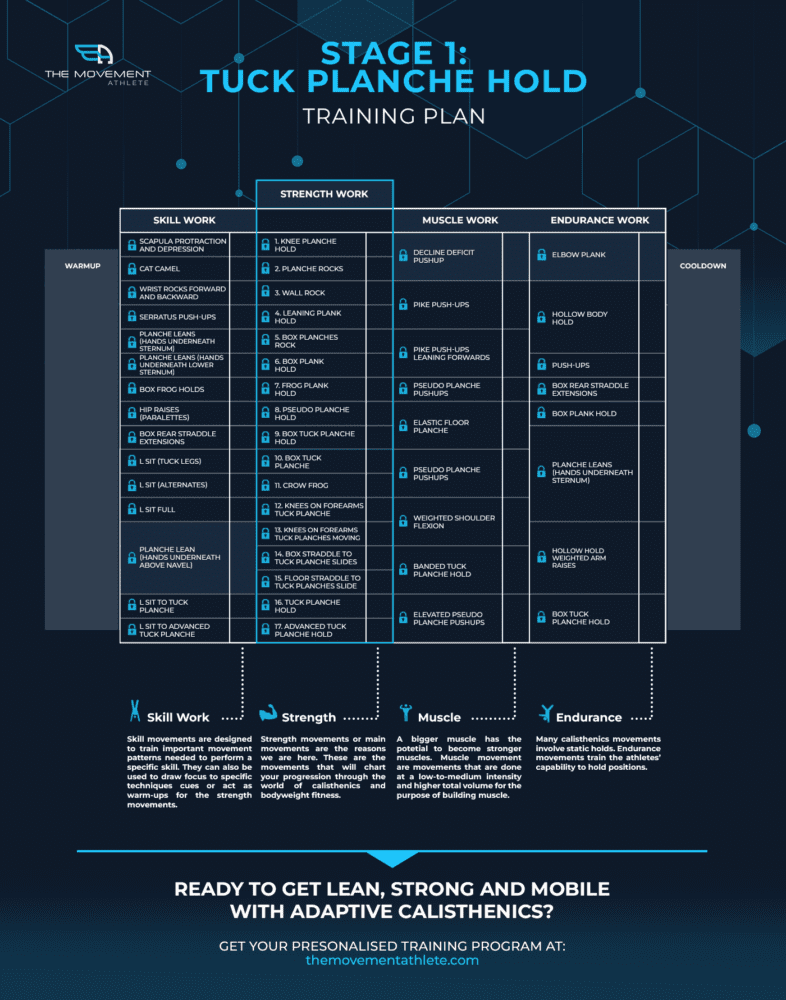
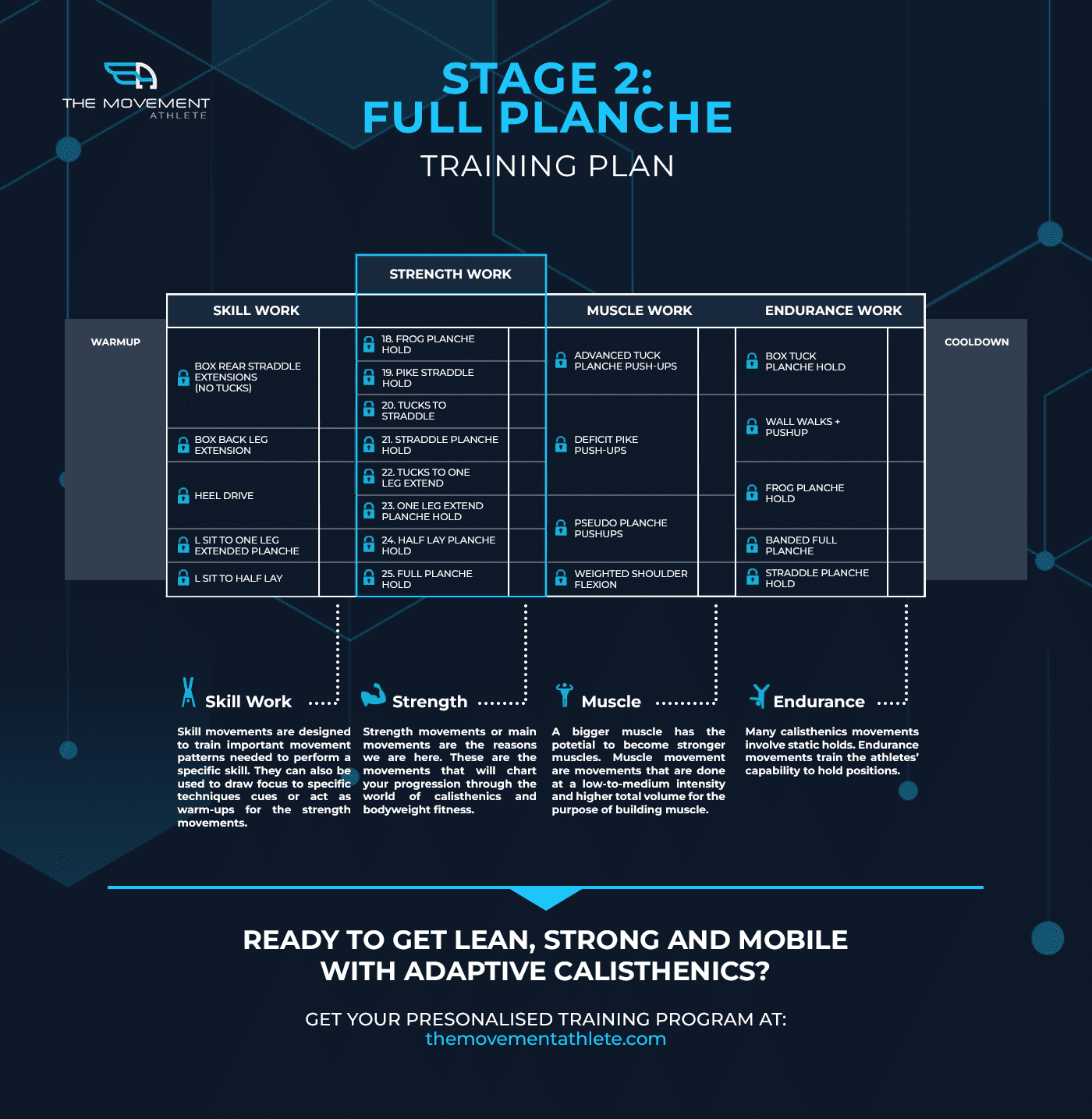
The Planche Progression
Here is our progression as well as briefs on committing to the planche journey.
Remember that planche is a highly complex skill that’s why don’t get overwhelmed too much when you see the long list of the progression. Each exercise helps massively in bridging gaps for you to achieve a full planche safely and efficiently.
Prerequisites: Push-up fundamentals & Bodyline fundamentals
Goal: Full planche
Priorities:
Our ultimate goal is to learn planche, but planche doesn’t happen overnight. It’s the result of the good habits you have built over time. Here are the elements that we need to learn and refine:
Body alignment
Straight-arm strength
Leaning forward with proper body posture
Upper and lower body awareness
Scapula protraction
Wrist mobility
General pushing strength
You can check out our article on “How to Perform the Perfect Planche” to review the form and the general requirements to hold the position.
🔑Key reminders you should be aware when you’re practicing your planche progressions:
-
- Watch Form – Once your form breaks, stop. It’s better to practice with short holds with good form than holding it longer but bad form. Build and maintain good habits as it will translate later on in your journey.
-
- Body Alignment – Most positions require a proper bodyline. Do not break the position.
-
- Body Awareness – You should be able to be aware of your mistakes and correct it while in holding the position.
-
- Body Control – Perform every move with control. When entering the static positions, do not rush.
-
- Breathing – It might be difficult to breathe especially when you get to hold a progression only when you’re holding your breath. Mindful breathing when exercises not only helps you perform better, it also helps you get stronger in the long run.
Strength Progression
You still need to solidify your form in order to progress faster and you can do that through these progressions:
1. Frog Planche Hold
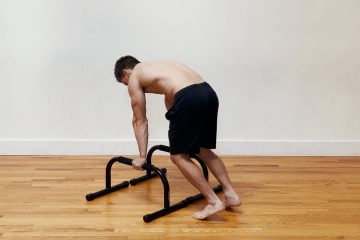
Planche journey begins with the frog planche hold. This exercise is perfect for familiarizing your body with the feeling of the straddle planche position. The leg position and forward lean are similar to the advanced tuck, but the open hip position requires lower body mobility.
How to Perform:
- Depress shoulders and protract the scapula.
- Place your hands on the floor shoulder-width apart with straight arms.
- Lean forward enough until your feet feel weightlessness.
- Tuck your knees just below your hands with extended hips.
- Lift your feet off the ground as you open your hips into a frog stance.
- Hold the position for a specified time.
2. Pike Straddle Hold
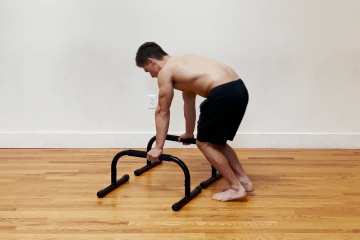
Pike straddle hold introduces a bend at the hips to lessen the lever compared to the straddle planche. This is an intermediate planche variation that lets you know you are near the straddle planche variation.
How to Perform:
- Protract and depress your shoulders with straight arms.
- Position your hands on the floor to prepare for the planche entry with legs piked.
- Lean forward enough until you feel the weight on your hands and shoulders. Feet must feel weightlessness.
- Lift legs off the ground while keeping hips lower than your shoulders.
- Hold the position for a specified time.
3. Tucks to Straddle
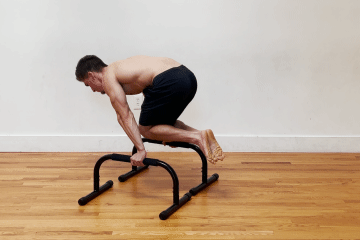
Transitional exercise such as this tuck to planche variation allows you to build strength and endurance towards straddle planche while letting you feel the difference in the forward lean. Keep in mind that if you want to move towards straddle, the forward lean is the key, and just extending the hips and legs will not help you alone.
How to Perform:
- Move into a tuck planche hold.
- Extend your hips and legs as you lean forward even more.
- Complete the lean and extension to arrive at the straddle planche form.
- Hold the position for a brief moment.
- Revert to tuck planche without breaking form.
- Repeat for specified repetitions.
4. Straddle Planche Hold
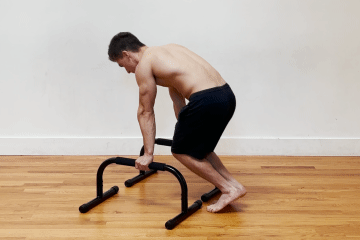
Straddle planche is already an amazing achievement that requires a high level of specific planche strength, technique, and mobility. The straddle leg position offers a shortened lever compared to full planche variation.
How to Perform:
- Protract and depress your shoulders with straight arms.
- Position your hands on the floor to prepare for the planche entry while your legs are in a straddle position.
- Lean forward enough until you feel the weight on your hands and shoulders. Feet must feel weightlessness.
- Lift legs off the ground while keeping hips lower than your shoulders.
- Hold the position for a specified time.
5. Tucks to One Leg Extend
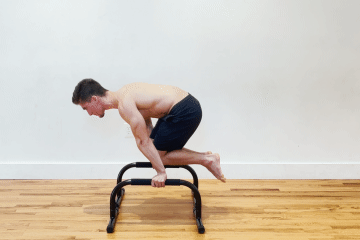
This exercise variation allows you to build strength for the one-leg extended planche position hold. The shifting motion keeps the exercise much easier compared to the full isometric hold.
How to Perform:
- Move into a tuck position.
- Lean forward even more as you extend one leg straight.
- Hold for a brief moment.
- Return to a tuck position.
- Switch legs and repeat alternately for specified repetitions.
6. One Leg Extend Planche Hold
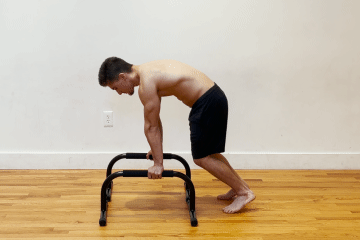
One leg extends planche hold is a form that simulates and is very close to the full planche position. One leg is positioned in an advanced tuck planche while the other is in the full planche position. The other extended leg lengthens the lever to increase the exercise intensity. Keep in mind to switch legs and do the planche variation for both leg positions.
How to Perform:
- Protract and depress your shoulders with straight arms.
- Position your hands on the floor to prepare for the planche entry while your legs are already in one leg planche position.
- Lean forward enough until you feel the weight on your hands and shoulders. Feet must feel weightlessness.
- Lift legs off the ground while keeping hips lower than your shoulders.
- Step normally back on the ground.
- Switch legs and repeat for specified repetitions.
7. Half Lay Planche Hold
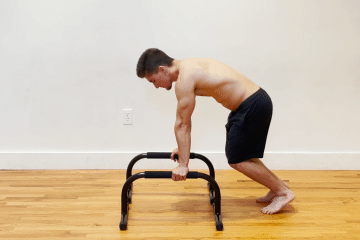
The half-lay position is the final step towards your full planche goal. The half lay lets you train with a lengthened lever but keep it easier compared to the full planche because of the bent legs. The hip extension adds the feeling close to the full planche.
How to Perform:
- Protract and depress your shoulders with straight arms.
- Position your hands on the floor to prepare for the planche entry with legs tucked.
- Lean forward enough until you feel the weight on your hands and shoulders. Feet must feel weightlessness.
- Lift legs off the ground and extend the hips. Let your legs remain bent.
- Hold the position for a specified time.
8. Full Planche Hold
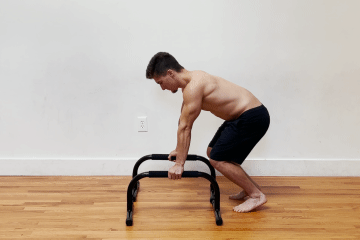
The full planche is the ultimate goal of planche training. It’s the most challenging planche body position because of the maximum body length with hips and legs fully extended.
How to Perform:
- Protract and depress your Shoulders with straight arms.
- Position your hands on the floor to prepare for the planche entry with legs straight.
- Lean forward enough until you feel the weight on your hands and Shoulders. Feet must feel weightlessness.
- Lift legs off the ground and extend the hips. Let your legs remain bent.
- Hold the position for a specified time.
Skill Element
The skill element now focuses on getting you to the correct form, technique and cueing to be able to optimize your performance when learning planche. It’s all about being effecient and learning good habits.
Remember that no matter how strong you are, without proper skill owkr, you will never master or learn planche.
Here are the exercises needed to learn the move:
1. Box Rear Straddle Extensions

Box extensions offer a scalable exercise to develop strength and control for the lower body, including the lower back, hips, glutes, and hamstrings that play an important role in the full-body tension. It also familiarizes you with the lower body requirement of planche. You need a form of a bench or workout box to execute the exercise efficiently.
How to Perform:
- Lie on a bench with your stomach down, and your hips are hanging off the surface.
- Extend your legs into a straddle position.
- Lift your legs upward.
- Hold the top position for a brief moment.
- Lower down with control.
- Repeat for specified repetitions.
2. Heel Drive
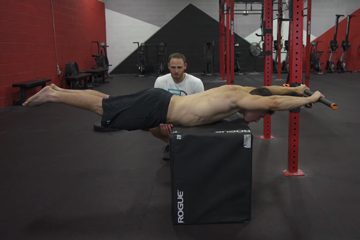
This exercise trains the posterior chain for the planche position. It’s an undervalued yet essential aspect if you want to master planche.
How to Perform:
- Lay on an elevated surface with your lower body hanging off the ground and legs straight.
- Lift your lower body until aligned with your upper body.
- Lower down with control.
- Repeat for specified repetitions.
3. L-sit to One Leg Extended Planche
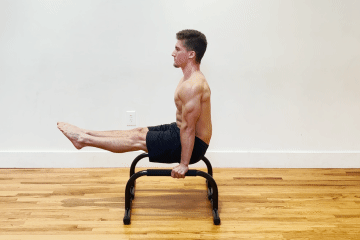
L-Sit to planche is a great exercise to learn and build strength for the planche hold. L-Sit also prepares the necessary shoulders strength and stability for the planche position. As you grow stronger, aim to use less momentum and facilitate the movement with only strength and control. In this exercise, L sit transitions into a one-leg extended planche.
How to Perform:
- Lie on a bench with your stomach down, and your hips are hanging off the surface.
- Straighten the leg while still hanging.
- Simultaneously extend your hips and legs to level with your upper torso.
- Hold the top position for a brief moment.
- Repeat for specified repetitions.
- Lower back to the starting position.
- Switch legs and repeat for specified repetitions.
4. L-sit to Half Lay
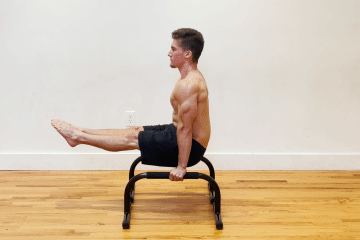
L-Sit to planche is a great exercise to learn and build strength for the planche hold. L-Sit also prepares the necessary shoulders strength and stability for the planche position. As you grow stronger, aim to use less momentum and facilitate the movement with only strength and control.
How to Perform:
- Begin in an L-Sit position.
- Swing your body forward and extend your hips backward while bending the knees to achieve the half-lay position.
- Lean forward enough to be able to hold the half-lay planche.
- Return to L-Sit position.
- Repeat the motion for specified repetitions.
Muscle Element
Very similar to the wall handstand muscle element, here you’ll focus more on other aspects than building muscle.
1. Advanced Tuck Planche Push-ups
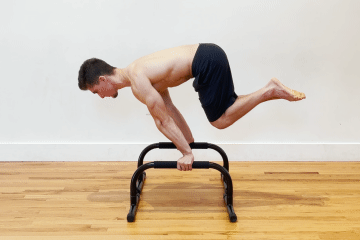
Advanced tuck planche builds general pushing strength that targets specific muscle groups for planche work. Endurance is also built as maintaining the proper planche technique is required. It’s best to be done on parallettes or any elevated surface to maximize the range of motion.
How to Perform:
- Position into an advanced tuck planche hold.
- Lower down until triceps go past 180 degrees while maintaining a good level of planche and form.
- Return to the top position with lock out arms again.
- Repeat for specified repetitions.
2. Deficit Pike Push-ups
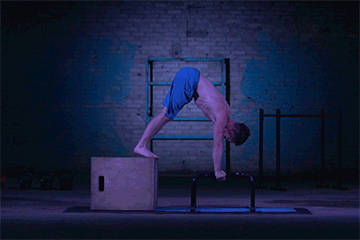
Deficit pike pushup on box is a lateral exercise done to strengthen deltoids, pectorals, trapezius, teres major, and triceps.
How to Perform:
- Place hands on parallel bars.
- Step feet up onto edge of box, body forming a V.
- Bend elbows lowering head in between arms.
- Press back up
- Repeat specified repetitions.
3. Pseudo Planche Pushups
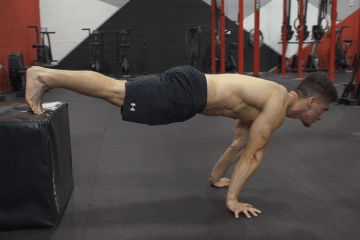
This is a more challenging push-up progression suited to build your specific strength for planche. It strengthens you both in straight-arm and bent-arm positions.
How to Perform:
- Start with a position close to an elevated surface.
- Begin in a push-up position.
- Place your feet on the elevated surface while keeping a good push-up posture.
- Lean forward to put more weight on your anterior deltoids.
- Lower down until your chest is close to the ground.
- Push back up in the starting position until your arms are straightened.
- Repeat the push-up posture for specified repetitions.
4. Weighted Shoulder Flexion
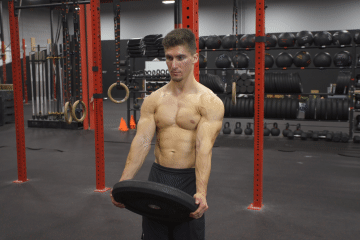
Weighted shoulder flexion allows you to target and overload the anterior deltoids and prep your joints in isolation safely and with better control with other factors.
How to Perform:
- Hold a dumbbell or weight plate in front of you with lockout arms.
- Raise your arms overhead until your mobility permits.
- Lowerdown with control.
- Repeat for specified repetitions.
Endurance Element
For endurance, you’ll train more difficult moves in order to hold the handstand.
So here’s the list of exercises:
1. Box Tuck Planche Hold
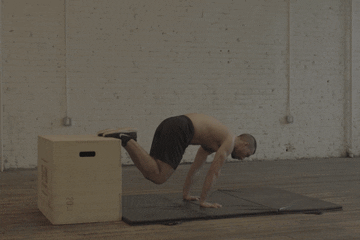
The box tuck plache hold is a variation of a plank. It is done with feet elevated on a box, and knees bent rather than straight. This exercise works to build abdominal, tricep, deltoid, and pectoral strength.
How to Perform:
- From a kneeling position in front of a box, lean forward onto your palms, straightening your elbows.
- Lift your right leg up, placing the top of your foot onto the box, knee bent towards the ground.
- Using your core, stabilize and lift up your left leg, and place foot on the box.
- Knees stay bent, core tightened.
- Hold position for specified time.
- Lower legs one at a time.
2. Wall Walks + Pushup
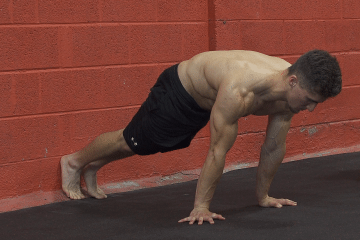
This exercise sequence conditions the shoulders for stability and control.
How to Perform:
- Begin in a push-up position close to a wall with your feet facing the wall.
- Walk your feet and hands backward until you reach a full handstand position with the belly facing the wall.
- Slowly walk back into the push-up position.
- Perform one push-up.
- Repeat the steps for specified repetitions.
3. Frog Planche Hold
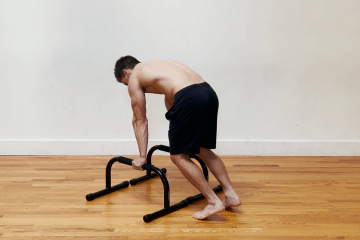
Frog planche is perfect for familiarizing your body with the feeling of the straddle planche position. The leg position and forward lean are similar to the advanced tuck, but the open hip position requires lower body mobility.
How to Perform:
- Depress shoulders and protract the scapula.
- Place your hands on the floor shoulder-width apart with straight arms.
- Lean forward enough until your feet feel weightlessness.
- Tuck your knees just below your hands with extended hips.
- Lift your feet off the ground as you open your hips into a frog stance.
- Hold the position for a specified time.
4. Band Assisted Full Planche
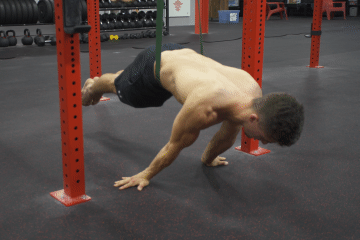
Band assistance helps you build strength and bridge the strength towards a higher planche progression.
How to Perform:
- Anchor the band in a stable position.
- Shoot your body through the band and place it on your hips.
- Perform the planche progression and hold for a specified time
5. Straddle Planche Hold
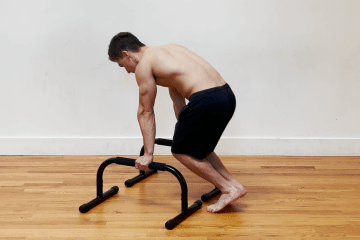
Once you get comfortable with the previous exercise, it’s time to hold the straddle planche. At this point, you have already achieved a move that not many individuals can do!
But even the strength and skill you have acquired, do not expect that you can already jump from straddle to full planche. The minor change in leg position provides a massive change in exercise intensity.
Focus on the form and keep on working with the basics and you will still get there. It’s so close!
How to Perform:
- Protract and depress your shoulders with straight arms.
- Position your hands on the floor to prepare for the planche entry while your legs are in a straddle position.
- Lean forward enough until you feel the weight on your hands and shoulders. Feet must feel weightlessness.
- Lift legs off the ground while keeping hips lower than your shoulders.
- Hold the position for a specified time.
With The Movement Athlete app, your planche program will be already structured depending on your skill level. It will also address your weak points in your planche and help you get over your your plateaus safely and progressively as possible.
You don’t have to worry about your program because the app got it covered for you. As you progress and unlock new skills, your program progresses with you!
Begin your personalized journey though this short assessment below.
TAKE THE ASSESSMENT NOW!
